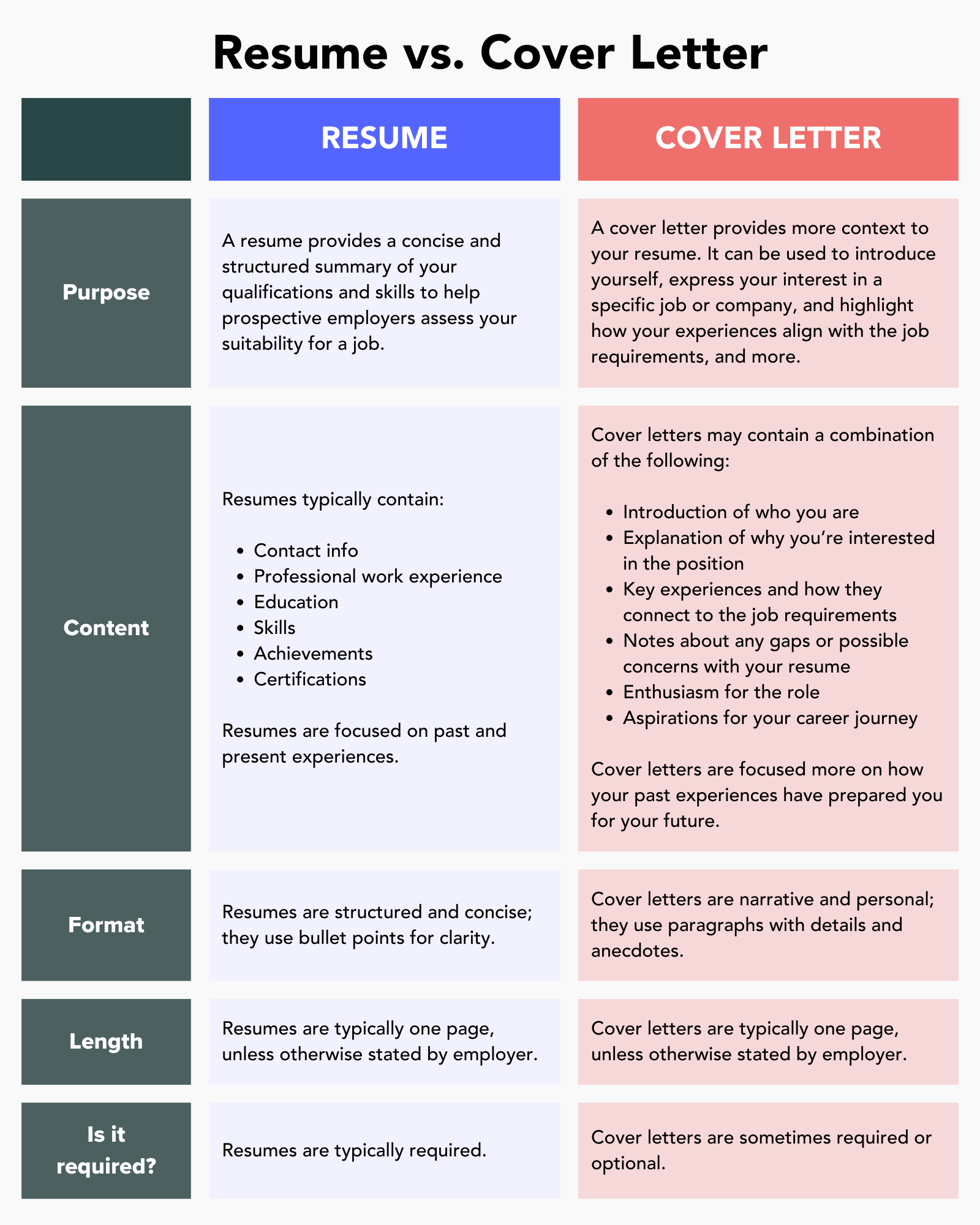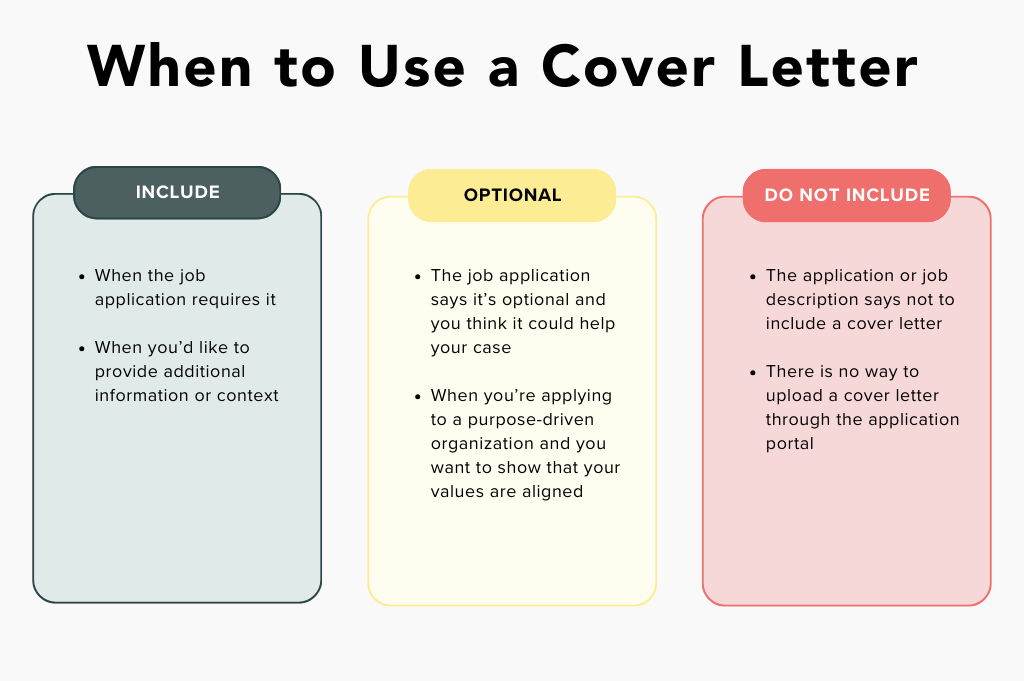Batman has Robin. Mario has Luigi. Simon has Garfunkel.
And resumes? They have cover letters.
They may not have the star power of the other duos on our list, but they do go hand in hand to create a strong job application. And, like every famous pair, they share this common goal despite bringing different things to the table.
We’re here to break down resumes and cover letters— how they’re the same, how they’re different, and how you can use each one to land the job you want.
Resume vs cover letter: How they are the same
Though they are different in many ways, resumes and cover letters have several similarities worth noting:
- They should both be catered to the job you’re applying for.
- Both should be no more than one page, unless otherwise stated by an employer or you’re applying for a job in a field where more detailed applications are commonplace.
Perhaps most of all, they share a common overarching goal: Help you secure an interview by demonstrating your suitability for a job.
RELATED: Letter of Introduction vs. Cover Letter: What’s the Difference

Resume vs cover letter: The big differences
That said, resumes and cover letters are not substitutes for one another. Though they share a common goal, they each have different purposes, unique content, and different formats.
Purpose
A resume provides a concise and structured summary of your qualifications and skills to help prospective employers assess your suitability for a job.
A cover letter provides more context to your resume. It can be used to introduce yourself, express your interest in a specific job or company, highlight how your experiences align with the job requirements, and more.
Content
Resumes are focused on past and present experiences.They typically contain:
- Contact info
- Professional work experience
- Education
- Skills
- Achievements
- Certifications
Cover letters, on the other hand, may contain a combination of the following:
- Introduction of who you are
- Explanation of why you’re interested in the position
- Highlight of key experiences and how they connect to the job requirements
- Notes about any gaps or possible concerns with your resume
- Enthusiasm for the role
- Aspirations for your career journey
Cover letters are focused more on how your past experiences have prepared you for your future— both at the company you’re applying for and your career as a whole.
Format
Resumes are structured and concise. They use bullet points for clarity and rarely, if ever, contain paragraphs. Recruiters spend an average of six to seven seconds looking at a resume, so you want to give them the major points that showcase why you’re qualified for the job in an easy-to-digest format.
Cover letters are narrative and personal. This is the time to let your personality shine through with paragraphs that contain more details and anecdotes. A cover letter typically contains an introduction, several body paragraphs, and a conclusion.
When to use a resume vs cover letter
A resume will almost always be required when applying for a job.
Cover letters will not always be required. Sometimes they will be optional. Other times, employers may not want you to submit one at all.

How to cater a resume to a job application
Catering your resume to a job application is a crucial step in the job search process. Here are some tips to help you tailor your resume effectively:
- Analyze the job description: Carefully read the job listing and take note of key skills, responsibilities, and qualifications to understand what the employer is looking for.
- Match your skills and experiences: Align your resume with the job description by touching on your relevant experiences and skills in the resume. For instance, if the job requires leadership skills, be sure to showcase your leadership experiences.
- Use keywords: Incorporate industry-specific keywords and buzzwords from the job description. This is especially important for resumes that will be scanned by Applicant Tracking Systems (ATS).
- Prioritize relevant experience: Go into more detail for job experiences that are more relevant to the job you’re applying for.
- Showcase transferable skills: If you are changing industries or roles, emphasize transferable skills that can be beneficial in the new position.
- Keep it concise and relevant: Avoid including experiences or skills that are not relevant to the job. A concise, tailored resume is more effective than a lengthy, generic one.
Remember, the goal of tailoring your resume is to make it as relevant as possible to the job you are applying for. While extraneous skills and experiences can help your case and show that you’re well-rounded, employers are really looking for what will help you succeed in that particular role.
How to cater a cover letter to a job application
Catering your cover letter to a specific job application is as crucial as tailoring your resume.
While the resume focuses on your qualifications and past experiences, the cover letter is your opportunity to make a more personal connection with the employer and further highlight why you’re a great fit for the job.
Here are some strategies to cater a cover letter to a company:
- Research the company: Understand the company’s values, culture, and recent developments. Use this information to demonstrate how your background and interests align with the company’s ethos. You can also mention a recent company achievement or a specific aspect of the company’s culture or mission that resonates with you.
- Address the letter specifically: Whenever possible, address the letter to a specific person, such as the hiring manager. Avoid generic salutations like “To Whom It May Concern” if you know names.
- Start strong: Open your cover letter with a compelling statement that grabs the reader’s attention. For instance, you might start by explaining why you are particularly excited about the job or the company.
- Relate your experience to the job description: Use the job description as a guide. Discuss specific experiences or skills that directly relate to the key responsibilities and qualifications listed.
- Tell a story: Unlike the resume, a cover letter gives you space to tell a story. Share a brief anecdote that demonstrates how you’ve successfully applied relevant skills or how you’ve overcome challenges similar to what you might face in the new role.
- Explain any gaps or transitions: If there are gaps in your resume or you’re making a career transition, the cover letter is a good place to briefly explain these.
- Highlight soft skills: Emphasize soft skills that are critical to the job but harder to convey on a resume.
A cover letter is your chance to make a memorable first impression and to provide context for your application. A well-crafted cover letter that speaks directly to the needs of the employer can significantly boost your chances of landing an interview.
Use your resume and cover letter to your advantage
Together, a resume and cover letter can be used to tell the complete story of your experience, skills, and ambitions. Your resume provides a concise look at your experience, while your cover letter fills in the gaps and adds a personal touch to your application. Always be sure to tailor both documents to the job that you’re applying for to show hiring managers that you’re the best fit for the job.
